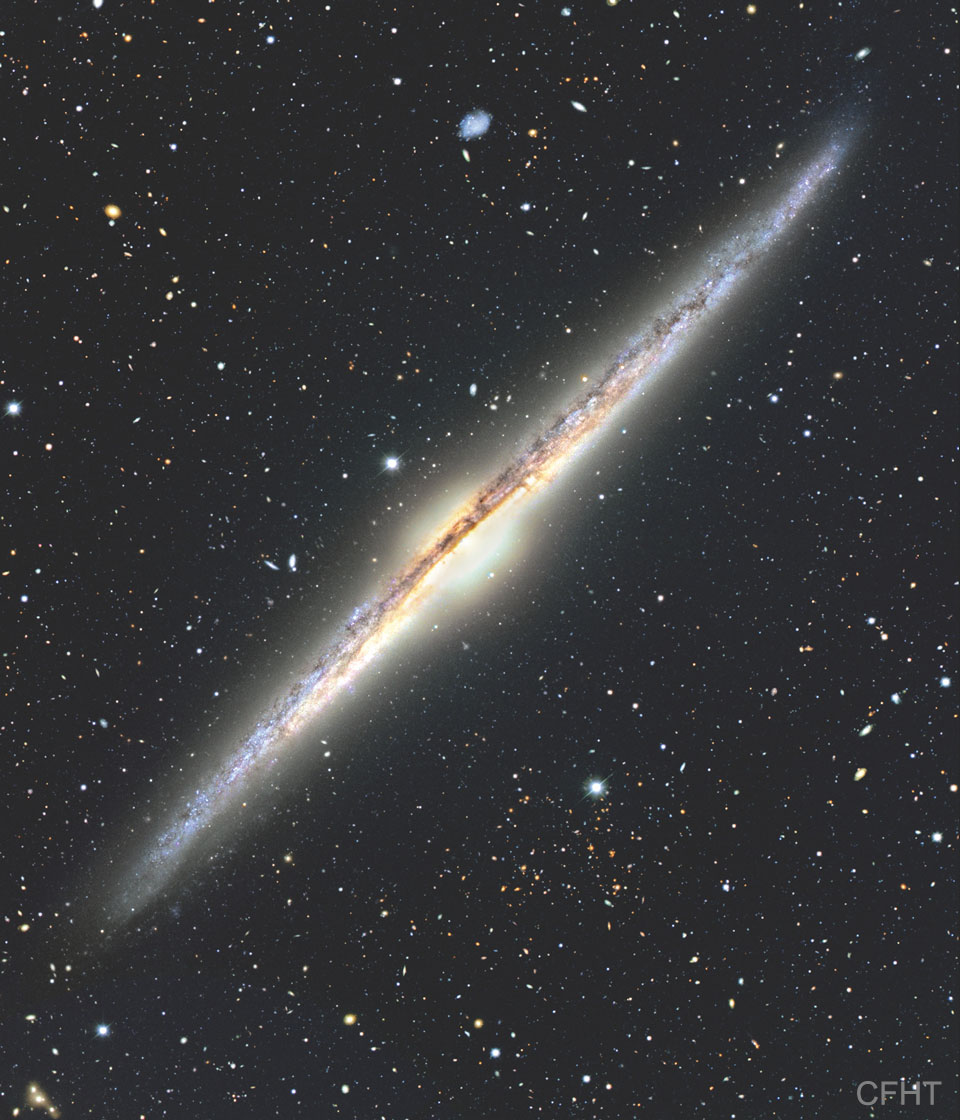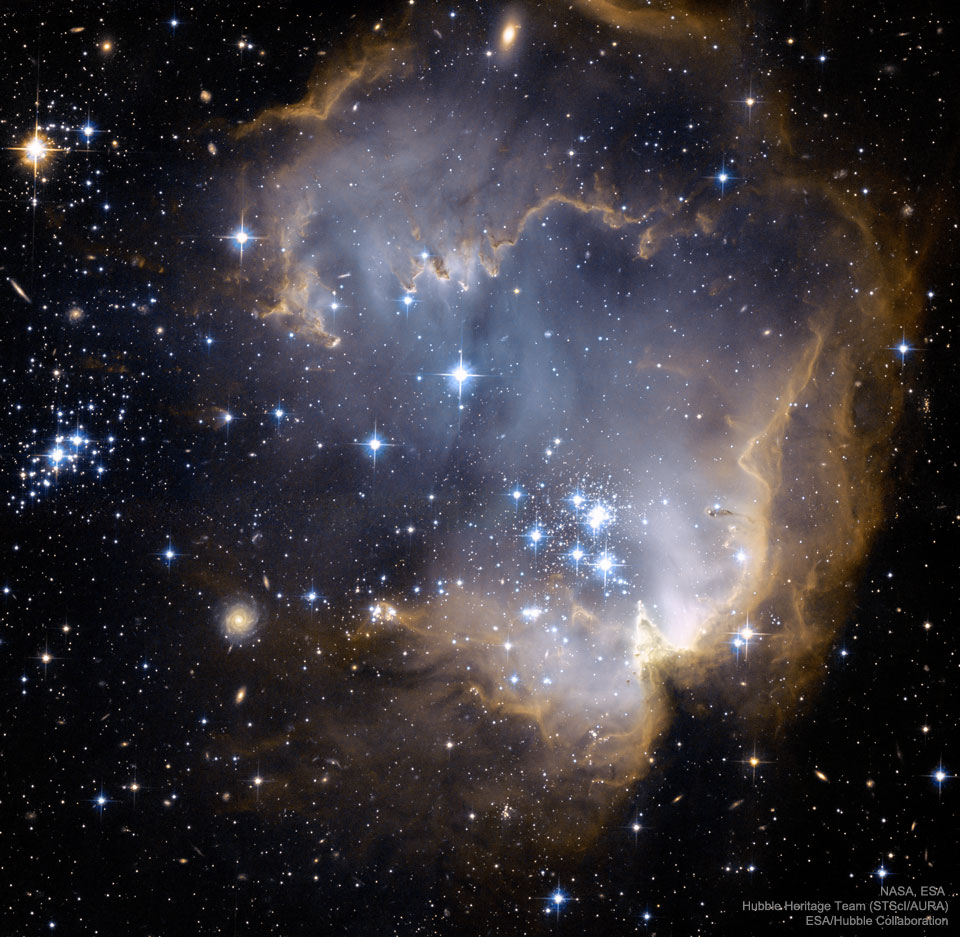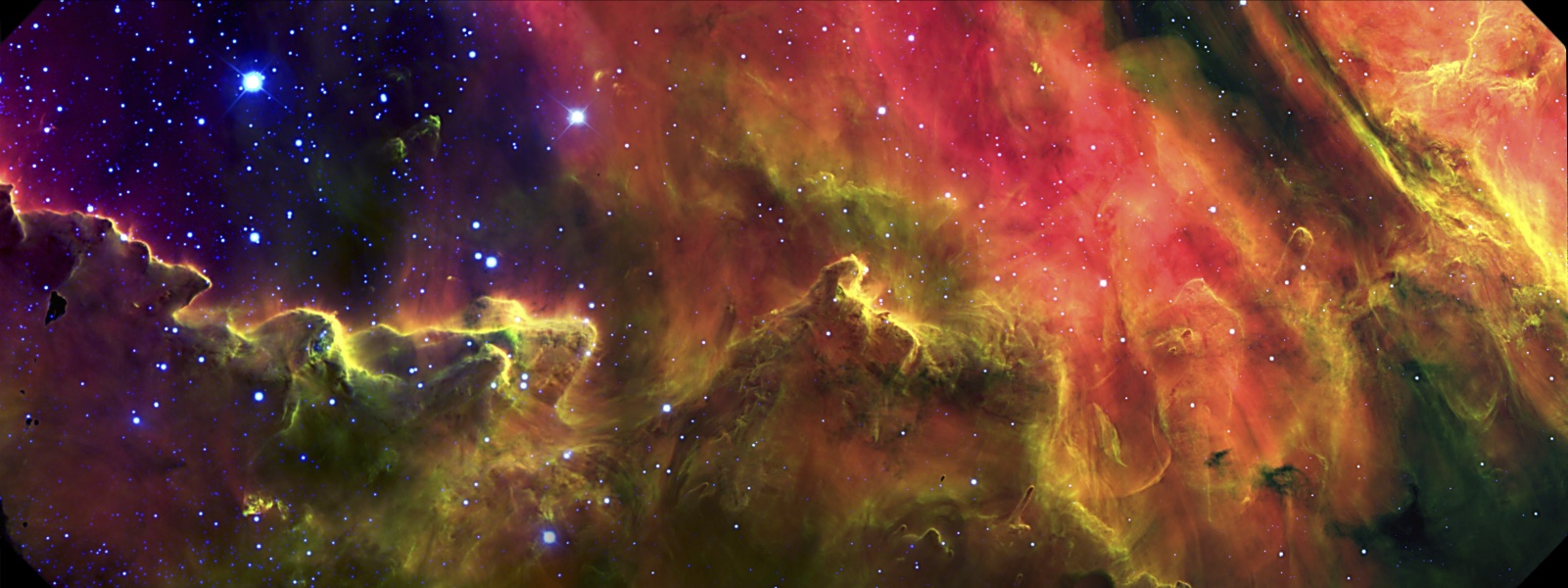Blog
Magnificent spiral galaxy NGC 4565 is viewed edge-on from planet Earth. Also known as the Needle Galaxy for its narrow profile, bright NGC 4565 is a stop on many telescopic tours of the northern sky, in the faint but well-groomed constellation Coma Berenices. This sharp, colorful image reveals the spiral galaxy’s boxy, bulging central core cut by obscuring dust lanes that lace NGC 4565’s thin galactic plane. An assortment of other background galaxies is included in the pretty field of view. Thought similar in shape to our own Milky Way Galaxy, NGC 4565 lies about 40 million light-years distant and spans some 100,000 light-years. Easily spotted with small telescopes, sky enthusiasts consider NGC 4565 to be a prominent celestial masterpiece Messier missed.

more...
Enya Patricia Brennan (Irish: Eithne Pádraigín Ní Bhraonáin /ˈɛnjə/; born 17 May 1961), known professionally as Enya, is an Irish singer, songwriter, record producer and musician. Born into a musical family and raised in the Irish-speaking area of Gweedore in County Donegal, Enya began her music career when she joined her family’s Celtic folk band Clannad in 1980 on keyboards and backing vocals. She left in 1982 with their manager and producer Nicky Ryan to pursue a solo career, with Ryan’s wife Roma Ryan as her lyricist. Enya developed her sound over the following four years with multitracked vocals and keyboards with elements of new age, Celtic, classical, church, and folk music. She has sung in ten languages.
Enya’s first projects as a solo artist included soundtrack work for The Frog Prince (1984) and the 1987 BBC documentary series The Celts, which was released as her debut album, Enya (1987). She signed with Warner Music UK, which granted her artistic freedom and minimal interference from the label. The commercial and critical success of Watermark (1988) propelled her to worldwide fame, helped by the international top-10 hit single “Orinoco Flow“. This was followed by the multi-million-selling albums Shepherd Moons (1991), The Memory of Trees (1995) and A Day Without Rain (2000). Sales of the latter and its lead single, “Only Time“, surged in the United States following its use in the media coverage of the September 11 attacks. Following Amarantine (2005) and And Winter Came… (2008), Enya took an extended break from music; she returned in 2012 and released Dark Sky Island (2015).
She is Ireland’s best-selling solo artist and second-best-selling artist behind U2, with a discography that has sold 26.5 million certified albums in the United States and an estimated 75 million records worldwide, making her one of the best-selling music artists of all time. A Day Without Rain(2000) remains the best-selling new-age album, with an estimated 16 million copies sold worldwide. Enya has won awards including seven World Music Awards, four Grammy Awards for Best New Age Album, and an Ivor Novello Award. She was nominated for an Academy Award and a Golden Globe Award for “May It Be“, written for The Lord of the Rings: The Fellowship of the Ring (2001).
more...William Scott Bruford (born 17 May 1949) is an English retired drummer, composer, producer, record label owner and musicologist who first gained prominence as a founding member of the progressive rock band Yes. After his departure from Yes, Bruford spent the rest of the 1970s playing in King Crimson (1972-1974) and touring with Genesis (1976) and U.K. (1978). Eventually he formed his own group (Bruford), which was active from 1978-1980.
In the 1980s, Bruford returned to King Crimson for three years, collaborated with several artists, including Patrick Moraz and David Torn, and formed his own jazz band Earthworks in 1986. He then played with his former Yes bandmates in Anderson Bruford Wakeman Howe, which eventually led to a very brief second stint in Yes. Bruford played in King Crimson for his third (and final) tenure from 1994-1997, after which he continued with a new configuration of Earthworks.
On 1 January 2009, Bruford retired from public performance, barring one private gig in 2011. He released his autobiography, and continues to speak and write about music. He operates his record labels, Summerfold and Winterfold Records. In 2016, after four-and-a-half years of study, Bruford earned a PhD in Music at the University of Surrey, in the same year Rolling Stone magazine ranked Bruford No. 16 in its list of the “100 Greatest Drummers of All Time”. He was inducted into the Rock and Roll Hall of Fame as a member of Yes in 2017.
more...Taj Mahal (born Henry Saint Claire Fredericks on May 17, 1942) is an American blues musician, singer-songwriter, multi-instrumentalist, actor, and film composer. He plays the guitar, piano, banjo, harmonica, and many other instruments, often incorporating elements of world music into his work. Mahal has done much to reshape the definition and scope of blues music over the course of his more than 50-year career by fusing it with nontraditional forms, including sounds from the Caribbean, Africa, India, Hawaii, and the South Pacific.
Mahal was born Henry Saint Claire Fredericks, Jr. on May 17, 1942, in Harlem, Manhattan, New York City, New York. Growing up in Springfield, Massachusetts, he was raised in a musical environment: his mother was a member of a local gospel choir and his father, Henry Saint Claire Fredericks Sr., was an Afro-Caribbean jazz arranger and piano player. His family owned a shortwave radio which received music broadcasts from around the world, exposing him at an early age to world music. Early in childhood he recognized the stark differences between the popular music of his day and the music that was played in his home. He also became interested in jazz, enjoying the works of musicians such as Charles Mingus, Thelonious Monk and Milt Jackson. His parents came of age during the Harlem Renaissance, instilling in their son a sense of pride in his Caribbean and African ancestry through their stories.
more...
Walter Dewey Redman (May 17, 1931 – September 2, 2006) was an American saxophonist who performed free jazz as a bandleader and with Ornette Coleman and Keith Jarrett.
Redman played tenor saxophone, though he occasionally also played alto, the Chinese suona (which he called a musette), and clarinet. His son is saxophonist Joshua Redman.
Redman was born in Fort Worth, Texas. He attended I.M. Terrell High School, and played in the school band with Ornette Coleman, Prince Lasha, and Charles Moffett. After high school, he briefly enrolled in the electrical engineering program at the Tuskegee Institute in Alabama but became disillusioned with the program and returned home to Texas. In 1953, he earned a bachelor’s degree in Industrial Arts from Prairie View Agricultural and Mechanical University. While at Prairie View, he switched from clarinet to alto saxophone, then to tenor. After graduating, he served for two years in the U.S. Army.
more...John Lenwood “Jackie” McLean (May 17, 1931 – March 31, 2006) was a North-American jazz alto saxophonist, composer, bandleader, and educator, and is one of the few musicians to be elected to the DownBeat Hall of Fame in the year of their death.
McLean was born in New York City. His father, John Sr., played guitar in Tiny Bradshaw‘s orchestra. After his father’s death in 1939, Jackie’s musical education was continued by his godfather, his record-store-owning stepfather, and several noted teachers. He also received informal tutoring from neighbors Thelonious Monk, Bud Powell, and Charlie Parker. During high school McLean played in a band with Kenny Drew, Sonny Rollins, and Andy Kirk, Jr. (the saxophonist son of Andy Kirk).
Along with Rollins, McLean played on Miles Davis‘ Dig album, when he was 20 years old. As a young man he also recorded with Gene Ammons, Charles Mingus (for Pithecanthropus Erectus), George Wallington, and as a member of Art Blakey‘s Jazz Messengers. McLean joined Blakey after reportedly being punched by Mingus. Fearing for his life, McLean pulled out a knife and contemplated using it against Mingus in self-defense, but later stated that he was grateful that he had not stabbed the bassist.
more...Near the outskirts of the Small Magellanic Cloud, a satellite galaxy some 200 thousand light-years distant, lies 5 million year young star cluster NGC 602. Surrounded by natal gas and dust, NGC 602 is featured in this stunning Hubble image of the region. Fantastic ridges and swept back shapes strongly suggest that energetic radiation and shock waves from NGC 602‘s massive young stars have eroded the dusty material and triggered a progression of star formation moving away from the cluster’s center. At the estimated distance of the Small Magellanic Cloud, the featured picture spans about 200 light-years, but a tantalizing assortment of background galaxies are also visible in this sharp multi-colored view. The background galaxies are hundreds of millions of light-years or more beyond NGC 602.

Robert Fripp (born 16 May 1946) is an English musician, songwriter, and record producer, best known as the guitarist, founder and longest-lasting member of the progressive rock band King Crimson. He has worked extensively as a session musician and collaborator, notably with David Bowie, Blondie, Brian Eno, Peter Gabriel, Daryl Hall, Midge Ure, Talking Heads, and David Sylvian. He has also contributed sounds to the Windows Vistaoperating system. His discography includes contributions to over 700 official releases.
Fripp is ranked 62nd on Rolling Stone magazine’s 2011 list of the 100 Greatest Guitarists of All Time after having been ranked 42nd by David Frickeon its 2003 list. Tied with Andrés Segovia, he also is ranked 47th on Gibson’s Top 50 guitarists of all time. His compositions often feature unusual time signatures, which have been influenced by classical and folk traditions. His innovations include a tape delay system known as “Frippertronics” and new standard tuning.
more...William Emanuel Cobham Jr. (born May 16, 1944) is a Panamanian-American jazz drummer who came to prominence in the late 1960s and early 1970s with trumpeter Miles Davis and then with the Mahavishnu Orchestra. According to AllMusic, Cobham is generally acclaimed as fusion’s greatest drummer.
He was inducted into the Modern Drummer Hall of Fame in 1987 and the Classic Drummer Hall of Fame in 2013. AllMusic biographer Steve Huey said, “Generally acclaimed as fusion’s greatest drummer, Billy Cobham’s explosive technique powered some of the genre’s most important early recordings – including groundbreaking efforts by Miles Davis and the Mahavishnu Orchestra – before he became an accomplished bandleader in his own right. At his best, Cobham harnessed his amazing dexterity into thundering, high-octane hybrids of jazz complexity and rock & roll aggression.” Cobham’s influence stretched far beyond jazz: including progressive rock contemporaries like Bill Bruford of King Crimson and Danny Carey of Tool.Prince played a version of Cobham’s Stratus in concert. Phil Collins, who named Mahavishnu Orchestra‘s The Inner Mounting Flame as a key influence on his early style said, “Billy Cobham played some of the finest drumming I’ve ever heard on that record.”
Born in Colón, Panama, Cobham moved with his family to Brooklyn, New York, when he was three. His father, Manuel, worked as a hospital statistician during the week and played piano on weekends. Cobham started playing drums at age four and joined his father four years later. When he was fourteen, he got his first drum kit as a gift after being accepted to The High School of Music & Art in New York City. He was drafted in 1965, and for the next three years he played with a U.S. Army band.
https://www.youtube.com/watch?v=k8hIqIGSY54
more...Betty Carter (born Lillie Mae Jones; May 16, 1929 – September 26, 1998) was an American jazz singer known for her improvisational technique, scatting and other complex musical abilities that demonstrated her vocal talent and imaginative interpretation of lyrics and melodies. Vocalist Carmen McRae once remarked: “There’s really only one jazz singer—only one: Betty Carter.”
Carter was born in Flint, Michigan, and grew up in Detroit, where her father, James Jones, was the musical director of a Detroit church and her mother, Bessie, was a housewife. As a child, Carter was raised to be extremely independent and to not expect nurturing from her family.
more...Undulating bright ridges and dusty clouds cross this close-up of the nearby star forming region M8, also known as the Lagoon Nebula. A sharp, false-color composite of narrow band visible and broad band near-infrared data from the 8-meter Gemini South Telescope, the entire view spans about 20 light-years through a region of the nebula sometimes called the Southern Cliff. The highly detailed image explores the association of many newborn stars imbedded in the tips of the bright-rimmed clouds and Herbig-Haro objects. Abundant in star-forming regions, Herbig-Haro objects are produced as powerful jets emitted by young stars in the process of formation heat the surrounding clouds of gas and dust. The cosmic Lagoon is found some 5,000 light-years away toward the constellation Sagittarius and the center of our Milky Way Galaxy. (For location and scale, check out this image superimposing the close-up of the Southern Cliff within the larger Lagoon Nebula. The scale image is courtesy R. Barba’.)

Brian Peter George St John le Baptiste de la Salle Eno RDI (/ˈiːnoʊ/; born Brian Peter George Eno; 15 May 1948) is an English musician, composer, record producer, visual artist, and theorist best known for his pioneering work in ambient music and contributions to rock, pop and electronica. A self-described “non-musician”, Eno has helped introduce unique conceptual approaches and recording techniques to contemporary music. He has been described as one of popular music‘s most influential and innovative figures.
Born in Suffolk, Eno studied painting and experimental music at the art school of Ipswich Civic College in the mid 1960s, and then at Winchester School of Art. He joined glam rock group Roxy Music as synthesizer player in 1971, recording two albums with the group but departing in 1973 amidst tensions with Roxy frontman Bryan Ferry. Eno went on to record a number of solo albums beginning with Here Come the Warm Jets (1974). In the mid-1970s, he began exploring a minimalist direction on releases such as Discreet Music (1975) and Ambient 1: Music for Airports (1978), coining the term “ambient music” with the latter.
Alongside his solo work, Eno collaborated frequently with other musicians in the 1970s, including Robert Fripp, Harmonia, Cluster, Harold Budd, David Bowie, and David Byrne. He also established himself as a sought-after producer, working on albums by John Cale, Jon Hassell, Laraaji, Talking Heads, Ultravox, and Devo, as well as the no wave compilation No New York (1978). In subsequent decades, Eno continued to record solo albums and produce for other artists, most prominently U2 and Coldplay, alongside work with artists such as Daniel Lanois, Laurie Anderson, Grace Jones, Slowdive, Karl Hyde, James, Kevin Shields, and Damon Albarn.
Dating back to his time as a student, Eno has also worked in other media, including sound installations, film, and writing. In the mid-1970s, he co-developed Oblique Strategies, a deck of cards featuring aphorisms intended to spur creative thinking. From the 1970s onwards, Eno’s installations have included the sails of the Sydney Opera House in 2009 and the Lovell Telescope at Jodrell Bank in 2016. An advocate of a range of humanitarian causes, Eno writes on a variety of subjects and is a founding member of the Long Now Foundation. In 2019, Eno was inducted into the Rock and Roll Hall of Fame as a member of Roxy Music.
more...Ellis Larkins (May 15, 1923 – September 30, 2002) was an American jazz pianist born in Baltimore, Maryland, known for his two recordings with Ella Fitzgerald: the albums Ella Sings Gershwin (1950) and Songs in a Mellow Mood (1954). He was also the leader in the first solo sides by singer Chris Connor on her album Chris (1954).
Larkins was the first African American to attend the Peabody Conservatory of Music, an institute in Baltimore. He began his professional playing career in New York City after moving there to attend the Juilliard School. While still at Juilliard, Larkins performed jazz piano with guitarist Billy Moore at Café Society Uptown and over the next ten years in his own groups, or in support of, clarinetist Edmond Hall and singers Helen Humes and Mildred Bailey. He recorded with Coleman Hawkins, and Dicky Wells in the 1940s. In the 1950s, he recorded with Ella Fitzgerald, Ruby Braff, and Beverly Kenney. His 1960s work included recordings or performances with Eartha Kitt, Joe Williams, Georgia Gibbs and Harry Belafonte.
Though he was best known as an accompanist, Larkins recorded several solo albums in the 1950s. In the 1970s, he performed regularly at several New York venues, including Gregory’s, a small bar on the Upper East Side.
more...Edmond Hall (May 15, 1901 – February 11, 1967) was an American jazz clarinetist and bandleader. Over his long career Hall worked extensively with many top performers as both a sideman and bandleader and is perhaps best known for the 1941 chamber jazz song “Profoundly Blue,” which is regarded as a pre-World War II jazz classic.
Born in Reserve, Louisiana, about 40 miles west of New Orleans on the Mississippi River, Hall and his siblings were born into a musical family. His father, Edward Blainey Hall, and mother, Caroline Duhe, had eight children, Priscilla (1893), Moretta (1895), Viola (1897), Robert (1899), Edmond (1901), Clarence (1903), Edward (1905) and Herbert (1907).
more...More Posts
- The Cosmos with NGC 2327
- Tommy Flanagan
- Son Bonds Day
- World Music with Angelita Montoya
- Daily Roots with Earl 16
- The Cosmos with Cygnus
- Sly Stone Day
- Ry Cooder Day
- Charles Lloyd Day
- Lightnin’ Hopkins Day
- World Music with Bohemian Betyars
- Daily Roots with Horace Andy & the Sticks
- RHYTHM ROOTS WORKSHOP 3-14-18
- The Cosmos with NGC 1277
- Quincy Jones Day
- Shirley Scott Day
- Robert Pete Williams Day
- World Music with Yorùbá Bàtá
- Daily Roots with Jackie Edwards & The Aggrovators
- RHYTHM ROOTS WORKSHOP 3-13-18